
|
| Name: _________________________ | Period: ___________________ |
This test consists of 5 multiple choice questions, 5 short answer questions, and 10 short essay questions.
Multiple Choice Questions
1. Some theorize that the practice of photography allows the disclosure of a ___________ truth.
(a) Hidden.
(b) Blanketed.
(c) Naked.
(d) Ugly.
2. It becomes imperative, in order to avoid cliche, to constantly be discovering new sources of ___________.
(a) Original beauty.
(b) Truth.
(c) Colors.
(d) Lighting.
3. How do beautiful things begin to seem cliched and dull? Through their ____________, things become cliched.
(a) Subjects.
(b) Colors.
(c) Repetition.
(d) Over exposure.
4. Or is photography a ________ using an incidentally mimetic process, as referenced by Sontag in the book?
(a) Assembly line.
(b) Forgery.
(c) High art.
(d) Truth telling.
5. Early in their history, photographs entered __________ where they were displayed in shows as were paintings.
(a) Grocery stores.
(b) Schools.
(c) Hotels.
(d) Museums.
Short Answer Questions
1. The real problem with bringing ________ photographs into mainstream is a procedure which contradicts the nature of most photographs.
2. The overall discussion in this chapter is that on some level, in photography, images are or supersede __________.
3. Both painting and photography share a devotion to traditional __________ within their finished pieces.
4. Photography requires dissociative __________ when the person is photographing an item or object.
5. The photographic __________ need not capture or immortalize transient defects, as it was now seen in society.
Short Essay Questions
1. What is the struggle that's described in relation to paintings versus taking photographs, according to Sontag?
2. How are photographs presented as art in the modern society, according to this chapter of the book?
3. What did the film Chung Kuo include that helped to present an accurate, though not flattering, picture of Chinese life?
4. What do most claim about the intentions of photography, according to the long essays in this chapter?
5. What does the final chapter have to present about the idea of images in relation to reality, something which may not be fully supported by the text?
6. What does modern photography seem to say about this subject of the photograph and its importance?
7. What does Sontag see as the central tension in photography, according to the discussion in this chapter?
8. Why is a photograph of an object a more reliable way of looking at an object, according to the text in this chapter?
9. What do the Chinese tastes prefer to see in their films, which made the Italian director a poor choice for the documentary on Chinese life?
10. What kinds of subjects does it seem that painting and photography seem to favor, according to the argument in this chapter?
|
This section contains 602 words (approx. 3 pages at 300 words per page) |

|




